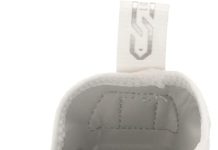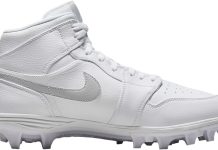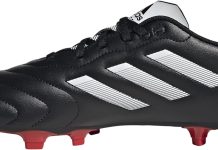Football cleats and soccer cleats are two types of athletic footwear specially designed for players of these popular sports. While both types of cleats are designed to provide traction on grassy fields and improve performance, there are some key differences between them. Football cleats typically have larger studs or spikes on the outsole to provide better grip and stability on the field, as football involves more lateral movements and quick changes in direction. On the other hand, soccer cleats have smaller, more numerous studs that are evenly distributed on the outsole, allowing for better maneuverability and control while dribbling and kicking the ball. Understanding these differences can help athletes choose the right type of cleats based on their specific sport and playing style.
Football Cleats
Review contents
Definition and Purpose
Football cleats are specialized athletic shoes designed for players participating in American football. The primary purpose of football cleats is to provide players with the necessary traction and stability on the field. These cleats are equipped with stud-like protrusions on the outsole, which help players grip the grass or turf and prevent slipping.
Components and Design Features
Football cleats are composed of several key components that work together to enhance performance and protect the player’s feet. The upper material is typically made of synthetic leather or a combination of materials to provide durability and support. The midsole often incorporates cushioning technology to absorb impact and reduce the risk of injuries. Additionally, football cleats feature a cleat plate, usually made of plastic or metal, which houses the studs that provide traction on the playing surface. The closure system, commonly consisting of laces or straps, ensures a secure and customized fit.
Different Types of Football Cleats
There is a wide range of football cleats available, each designed to cater to different player positions and playing styles. Skill position cleats are lightweight and built for speed, with low-cut designs that allow for quick movements and agility. Linemen cleats, on the other hand, prioritize stability and support with higher ankle collars and heavier construction. Additionally, there are specialized cleats for specific playing surfaces, such as firm ground, turf, or indoor.
This image is property of soccernovo.com.
Soccer Cleats
Definition and Purpose
Soccer cleats, also known as football boots in some parts of the world, are specifically designed for the game of soccer (or football). Similar to football cleats, the primary purpose of soccer cleats is to provide players with traction on the field. However, there are notable differences in the design and features of soccer cleats compared to football cleats.
Components and Design Features
Soccer cleats share some similarities with football cleats in terms of their composition. They typically have synthetic leather or textile uppers that offer durability and flexibility. The midsole may feature cushioning technologies to provide comfort during long matches. However, one of the most distinctive design features of soccer cleats is the outsole, which is equipped with smaller, more numerous studs that maximize traction and maneuverability on the soccer field. Additionally, soccer cleats often feature a lower-cut design to promote agility and freedom of movement.
Different Types of Soccer Cleats
Similar to football cleats, there are various types of soccer cleats designed for different player positions and playing conditions. Forwards and attacking players often opt for lightweight, low-cut cleats that prioritize speed and agility. Midfielders require a balance between agility and support, while defenders and goalkeepers benefit from cleats with enhanced stability and protection. Moreover, soccer cleats are available in different configurations of stud patterns to adapt to different playing surfaces, such as firm ground, artificial turf, or indoor courts.
This image is property of diffeology.com.
Key Differences Between Football Cleats and Soccer Cleats
Playing Surface
One of the key differences between football cleats and soccer cleats is the playing surface for which they are designed. Football cleats are primarily used on grass or turf fields, where the studs provide grip and prevent slipping. In contrast, soccer cleats are designed for various playing surfaces, including grass, artificial turf, and indoor courts. The studs on soccer cleats are usually shorter and more numerous, allowing for better traction and maneuverability on different surfaces.
Studs and Traction
Another significant difference lies in the design of the studs on the outsole of the cleats. Football cleats generally have fewer, longer studs made of plastic or metal. These studs are strategically placed to provide a strong grip and stability on the grass or turf. In contrast, soccer cleats feature numerous smaller studs that are designed to maximize traction and agility on the soccer field.
Upper Material
The material used for the upper of football and soccer cleats also differs. Football cleats often have synthetic leather uppers or a combination of materials that provide durability and support. Soccer cleats, on the other hand, commonly feature synthetic leather or textile uppers that offer flexibility and allow for better ball control. The choice of material in soccer cleats is often influenced by the need for a soft touch on the ball.
Weight and Durability
Football and soccer cleats vary in terms of weight and durability. Due to the nature of the game and the physical demands placed on football players, football cleats tend to be heavier and more durable to withstand the rigors of the sport. Soccer cleats, on the other hand, are generally lighter in weight to promote speed and agility. However, this often comes at the expense of some durability, as soccer cleats are not subjected to the same level of physical contact as football cleats.
Ankle Support
Ankle support is another differentiating factor between football cleats and soccer cleats. Football cleats, particularly those designed for linemen and players in positions that require more physical contact, often feature higher ankle collars. These collars provide additional support and stability to protect the ankles from injury. Soccer cleats, in contrast, typically have lower-cut designs to allow for freedom of movement and agility.
Design Style
Lastly, the design style of football cleats and soccer cleats often varies. Football cleats tend to have a more rugged and aggressive appearance, reflecting the physicality of the sport. They may feature bold colors, strong lines, and additional padding or reinforcement in certain areas. Soccer cleats, on the other hand, often prioritize sleekness and simplicity. They may have a streamlined silhouette and come in a wide range of vibrant colors to reflect the individuality and flair of the players.
This image is property of revupsports.com.
Choosing the Right Cleats for Your Sport
Analyzing the Playing Surface
When selecting the appropriate cleats for your sport, it is essential to consider the playing surface. If you primarily play football on grass or turf, football cleats with longer studs will offer the necessary traction and prevent slipping. However, if you participate in soccer on various playing surfaces, such as grass, artificial turf, or indoor courts, opting for soccer cleats with shorter studs or multiple stud patterns will ensure optimal performance.
Considering Your Position
Your position on the field also plays a role in determining the ideal cleats. Football players in positions that require agility and speed, such as wide receivers or running backs, may benefit from low-cut, lightweight cleats. On the other hand, linemen and players in positions that require stability and physicality, such as offensive or defensive linemen, can opt for football cleats with higher ankle collars and greater durability. In soccer, forwards and attacking players may prefer lightweight cleats for speed and quick movements, while defenders may prioritize stability and protection.
Taking Comfort and Fit into Account
Comfort and fit should be another crucial consideration when choosing cleats for your sport. It is essential to try on different brands and models to find the one that provides the most comfortable fit for your individual foot shape. Properly fitting cleats should offer some room in the toe box, preventing discomfort and potential foot injuries during extended periods of play. Additionally, considering factors such as arch support and cushioning can further enhance comfort and prevent discomfort on the field.
Prioritizing Personal Preference
Ultimately, personal preference and style should also be taken into account when selecting cleats. While functionality and performance are crucial, feeling confident and comfortable in your cleats can significantly impact your overall performance. Choosing a design or color that reflects your personality and style can help boost confidence and motivation on the field.
This image is property of www.metroleague.org.
Maintenance and Care
Cleaning and Drying
Proper maintenance and care of your cleats are essential to prolong their lifespan and maintain their performance. After each game or practice, it is crucial to remove any excess dirt or mud from the cleats. Using a soft brush or cloth, gently clean the upper and outsole to prevent the accumulation of debris that can affect traction and performance. It is also important to allow the cleats to air dry naturally after cleaning, avoiding direct heat sources that can damage the materials.
Replacing Studs
Over time, the studs on your cleats may wear down, compromising their traction and stability. Most brands offer replacement studs that can be easily screwed onto the cleat plate. Regularly inspecting and replacing worn or damaged studs will ensure optimal performance and minimize the risk of injury on the field.
Storage and Protection
Proper storage and protection are vital to keep your cleats in optimal condition. After each use, it is recommended to store them in a cool and dry area, away from direct sunlight or extreme temperatures. Storing your cleats in a bag or separate compartment will prevent them from getting damaged or dirty. Additionally, using shoe trees or stuffing the cleats with newspaper can help maintain their shape and prevent any potential deformities during storage.
This image is property of cdn.shortpixel.ai.
Conclusion
Football cleats and soccer cleats serve the same fundamental purpose of providing traction on the field, but they differ in various aspects, from design to performance characteristics. Understanding the distinctions between the two will enable players to choose the ideal cleats for their chosen sport. By considering factors such as playing surface, stud design, upper material, ankle support, and personal preference, athletes can make an informed decision when selecting cleats. Additionally, proper maintenance and care will ensure that the cleats last longer and perform at their best game after game. So whether you lace up for football or soccer, choosing the right cleats will undoubtedly enhance your performance and enjoyment of the game.










































